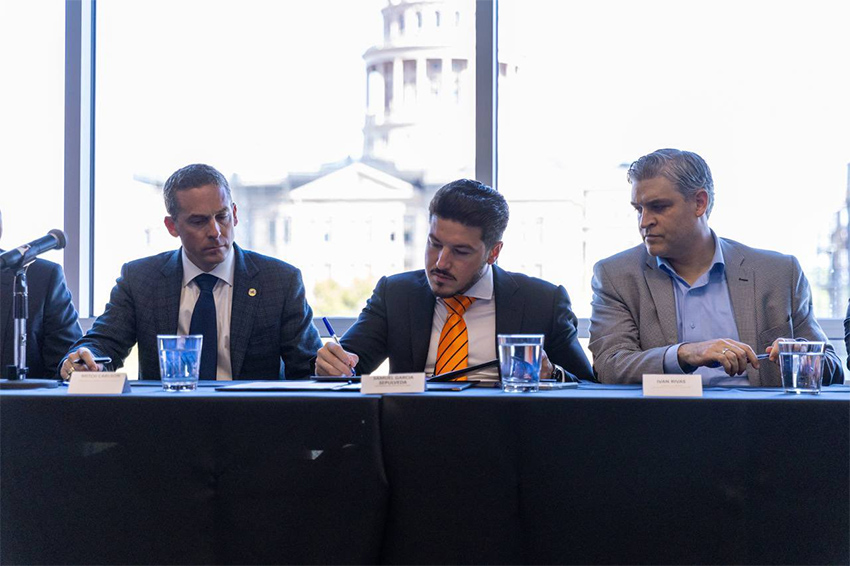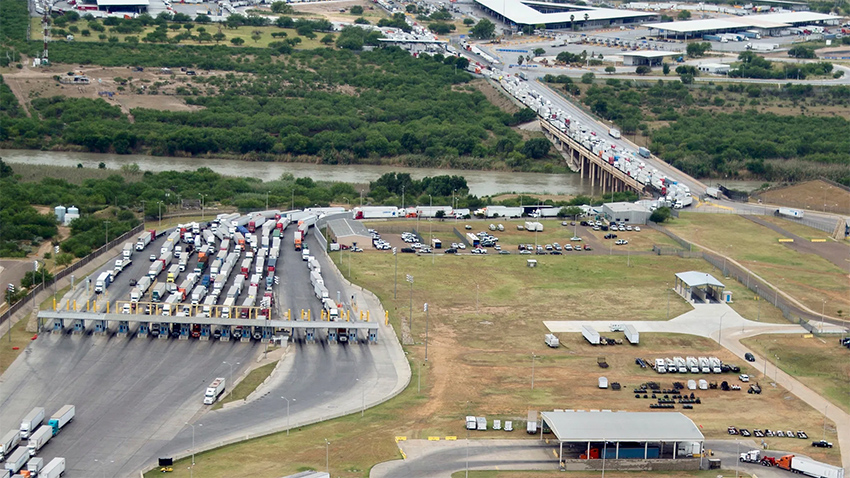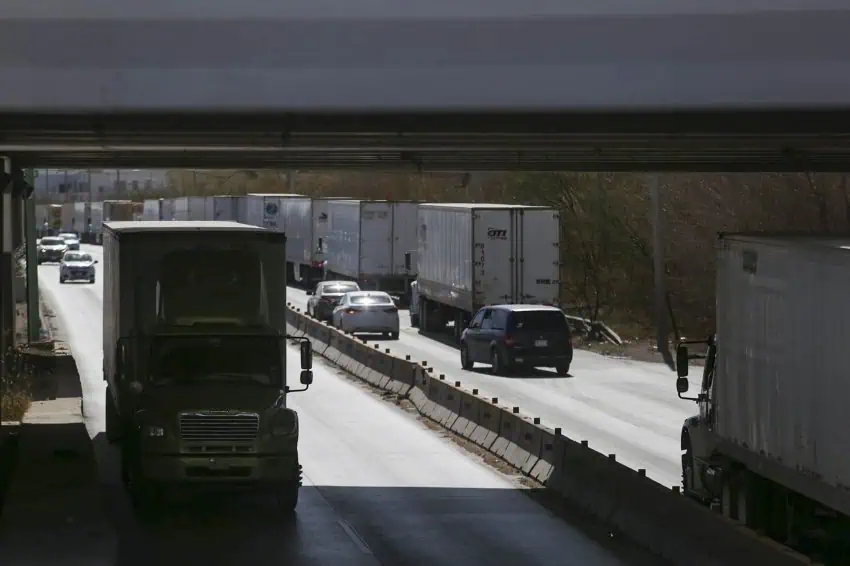A futuristic form of freight forwarding infrastructure could begin moving cargo across the Mexico-United States border in the early 2030s.
Green Corridors, a startup company based in Texas, is proposing to build a 265-kilometer-long elevated “guideway” between Laredo, Texas, and Monterrey, Nuevo León, along which autonomous freight-carrying shuttles would run.
United States President Donald Trump issued a presidential permit for the US $10 billion project this month. Green Corridors CEO Mitch Carlson told the Freight Waves publication last week that the next step is to obtain the construction and right-of-way permits needed for the project on both sides of the border.
“We are acquiring the concession agreement for the right-of-way for Highway 1 in the state of Nuevo León,” Carlson told Freight Waves.
“We’re working with the Mexican federal and state government very closely,” he said.
Carlson said he expects that construction of the elevated guideway will be completed in 2031, allowing a testing phase to commence.
The project
According to the Green Corridors website, the company intends to build a “groundbreaking, sustainable GC-IFTS,” or Green Corridors Intelligent Freight Transport System.
The elevated guideway is slated to connect to two freight terminals in Laredo and two in Monterrey. The size of each of those terminals would be around 100 acres (40.4 hectares/404,000 square meters), according to Carlson.
Freight truck drivers would enter the terminals and drop off their 53-foot dry van trailers, which “would then be loaded onto autonomous diesel-electric hybrid shuttles that travel along a designated path, much like a monorail,” The Wall Street Journal reported.
“When the shuttle arrives at the other end of the guideway, truckers would pick up a trailer and carry the goods farther into the U.S. or Mexico,” the newspaper said.
“We are building it to have a max capacity of 10,000 [trailers] in each direction per day,” Carlson told Freight Waves.
The CEO told The Wall Street Journal that Green Corridors is negotiating with landowners to acquire the land needed to build the terminals. The June 9 permit issued by Trump states that “the permittee is responsible for obtaining any required Federal, State, and local permits, approvals, and authorizations prior to commencing construction activities.”

It also states that the permit “shall expire 5 years from the date of its issuance if the Permittee has not commenced construction of the Border facilities by that date.”
Carlson told Freight Waves that the estimated cost of the GC-IFTS is $6-10 billion. However, he cited a price tag of $10 billion or more in an interview with The Wall Street Journal.
Carlson said that Green Corridors would charge companies a fee to move freight on its elevated guideway. He said he envisions the project as something that would complement the movement of freight by road and railway. Indeed, tractor-trailers and trains will be required to get cargo to terminals in Monterrey and Laredo, and to pick it up and take it to its final destination after it has crossed the border.
The project “requires no public funds or tax dollars” as the GC-IFTS is “funded by private capital,” according to the company’s website.
The Wall Street Journal reported that the project is backed by investors including the Swinbank family office in Houston, Druker Capital in New York and Chang Robotics Fund in Jacksonville, Florida.
Green Corridors appears to be seeking additional investment, saying on its website that it “offers an opportunity to invest in transformational infrastructure that fixes a visible problem at the U.S.’s largest [inland] port.”
The benefits of an elevated, automated corridor to move freight
Green Corridors says it is “on a mission to improve security and efficiency at the busiest international trade corridor in North America.”
According to a video about the elevated guideway project published on the company’s website, $320 billion worth of goods passes over the border between Laredo, Texas, and Nuevo Laredo, Tamaulipas, annually and 70% of freight is transported by tractor-trailers that make 3.3 million crossings per year.
These commercial vehicles “face unacceptable delays” that are costly and projected to get worse in coming decades, according to Green Corridors.

“Bridge expansion and more resources will not overcome the problem at Port Laredo,” the company asserts. “But Green Corridors’ Intelligent Freight Transport System will.”
In its video, Green Corridors describes its proposed system as “the future of freight” and says it will allow for the “unimpeded flow” of goods, have “unlimited capacity” and operate 24 hours per day every day of the year.
On its website, the company says its project “offers a solution at Port Laredo that will benefit future generations to come by reducing congestion, bypassing gridlocked areas, and increasing border security.”
It also says that the new freight transportation system will:
- Be environmentally friendly, as “our freight shuttles,” powered by a “hybrid propulsion system,” will “reduce emissions by 75%, providing a greener alternative to diesel trucking.”
- Substantially reduce the overall cost of freight transportation “compared to current market options.”
- Include “sustainable inland terminals” that will be equipped with “solar arrays, regenerative cranes, and hybrid power.”
- Integrate “real-time monitoring, bi-national customs collaboration [and] 100% freight screening” and guarantee the “secure, tamper-proof” transport of goods.
“We can move this freight between Monterrey and Laredo for significantly less cost and less emissions,” Carlson told Freight Waves.
The bigger picture
Mexico and the United States are each other’s largest trade partner, with two-way trade worth almost $840 billion last year. As export-focused companies continue to relocate to Mexico or expand their existing operations here, demand for freight services to the United States will only increase in coming years.
Truck crossings into Laredo — where large quantities of auto parts, vehicles, appliances and electronics enter the United States — increased 28% in 2024 compared to 2019, according to U.S. government data cited by The Wall Street Journal.

Even though some Mexican products including steel, aluminum and vehicles are currently subject to tariffs when entering the United States, Michigan State University logistics professor Jason Miller told the Journal that he expects trade between the U.S. and Mexico to continue to grow in coming years, especially if U.S. duties on Chinese goods are higher than those on Mexican goods.
Mexico, of course, has a free trade agreement with the United States (and Canada), whereas China does not.
Miller said that U.S. protectionism against China is “going to result in certainly some shifting of production from China to Mexico.”
As it seeks to capitalize on what has been described as a “once-in-a-generation” nearshoring opportunity for Mexico, the Mexican government is actively seeking to attract foreign investment across a range of sectors with its Plan México economic initiative and associated projects.
The elevated guideway Green Corridors is planning to build could allow companies that operate in Mexico and the U.S. to get their goods to consumers — and each other — more quickly and economically while reducing carbon emissions and pressure on border infrastructure.
The project would thus support the high levels of economic integration between Mexico and the United States, which, along with their USMCA partner Canada, operate what has been called a “co-production system,” providing essential inputs to each other that allow final goods to be produced.
With reports from The Wall Street Journal and Freight Waves
